Essential fatty acids: Boost heart health, brain function, and fight inflammation with 20 lifesaving food options for a vibrant life.
“20 Delicious Omega-3 Foods for a Healthier Lifestyle”

Are you feeling tired, moody, or struggling with inflammation? Your diet might be missing a crucial nutrient: essential fatty acids. 🐟💪
Incorporating Omega-3-rich foods into your diet can significantly improve your health.
Incorporating foods rich in essential fatty acids into your diet can significantly improve your health.
Ready to revolutionize your health with the power of Omega-3? 🌟 In this blog post, we’ll dive into “20 Lifesaving Omega-3 Foods for a Healthier Lifestyle.” We’ll explore everything from fish-based powerhouses to plant-based alternatives, and even fortified foods that can give you an Omega-3 nutrient boost. Whether you’re a seafood lover or a strict vegan, there’s a source for everyone. Let’s embark on this journey to better health, starting with understanding what Omega-3 really is and why it’s so crucial for our wellbeing.
Ready to revolutionize your health with the power of essential fatty acids? 🌟 In this blog post, we’ll dive into “20 Lifesaving Foods for a Healthier Lifestyle.” We’ll explore everything from fish-based powerhouses to plant-based alternatives, and even fortified foods that can give you an essential fatty acid boost. Whether you’re a seafood lover or a strict vegan, there’s a source for everyone. Let’s embark on this journey to better health, starting with understanding what essential fatty acids really are and why they’re so crucial for our wellbeing.
Understanding Essential Fatty Acids
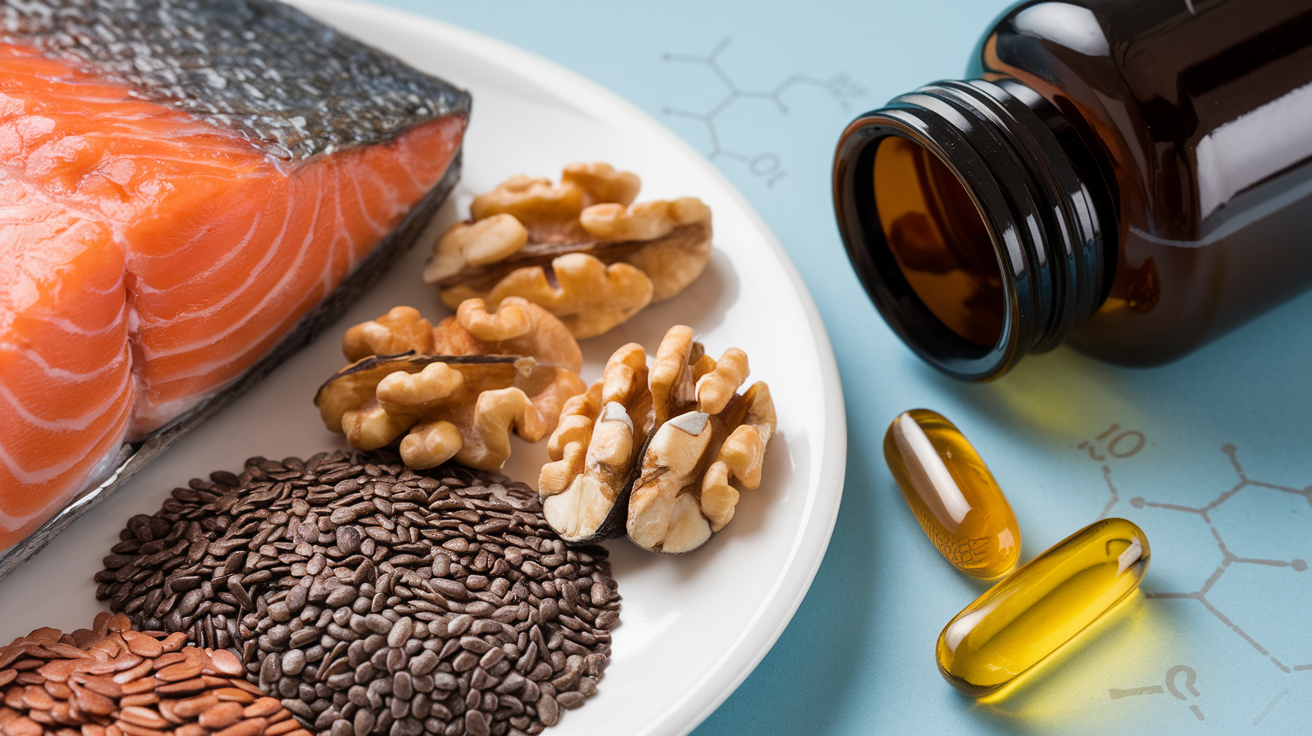
Essential nutrients for optimal health
Omega-3 fatty acids are crucial components of a healthy diet, playing vital roles in various bodily functions. These nutrients cannot be produced by the body and must be obtained through food or supplements. They are renowned for their numerous health benefits, including:
Essential fatty acids are crucial components of a healthy diet, playing vital roles in various bodily functions. These nutrients cannot be produced by the body and must be obtained through food or supplements. They are renowned for their numerous health benefits, including:
- Supporting heart health
- Reducing inflammation
- Improving brain function
- Promoting eye health
- Enhancing mood and mental well-being
Their importance in maintaining optimal health cannot be overstated, making them a key focus for those seeking to improve their overall well-being.
Types of essential fatty acids: EPA, DHA, and ALA
There are three main types of fatty acids, each with unique properties and sources:
| Type | Full Name | Primary Sources | Key Benefits |
|---|---|---|---|
| EPA | Eicosapentaenoic Acid | Fatty fish, algae | Anti-inflammatory, heart health |
| DHA | Docosahexaenoic Acid | Fatty fish, algae | Brain function, eye health |
| ALA | Alpha-Linolenic Acid | Plant-based sources | Converted to EPA and DHA in the body |
EPA and DHA are primarily found in marine sources, while ALA is abundant in plant-based foods. The body can convert ALA to EPA and DHA, but the conversion rate is relatively low, making direct consumption of EPA and DHA beneficial for many individuals.
Recommended daily intake
The recommended daily intake of essential fatty acids varies depending on factors such as age, gender, and health status. However, general guidelines suggest:
- Adults: 250-500 mg of combined EPA and DHA per day
- Pregnant and breastfeeding women: At least 300 mg of DHA per day
- Children: Varies by age, typically ranging from 50-100 mg per day
For ALA, the adequate intake is:
Including essential fatty acid-rich foods in your meals can enhance your overall well-being.
- Adult men: 1.6 grams per day
- Adult women: 1.1 grams per day
It’s important to note that these are general recommendations, and individual needs may vary. Consulting with a healthcare professional can help determine the optimal intake for your specific health goals and conditions.
Including foods rich in essential fatty acids in your meals can enhance your overall well-being.
Fish: The Ultimate Powerhouses
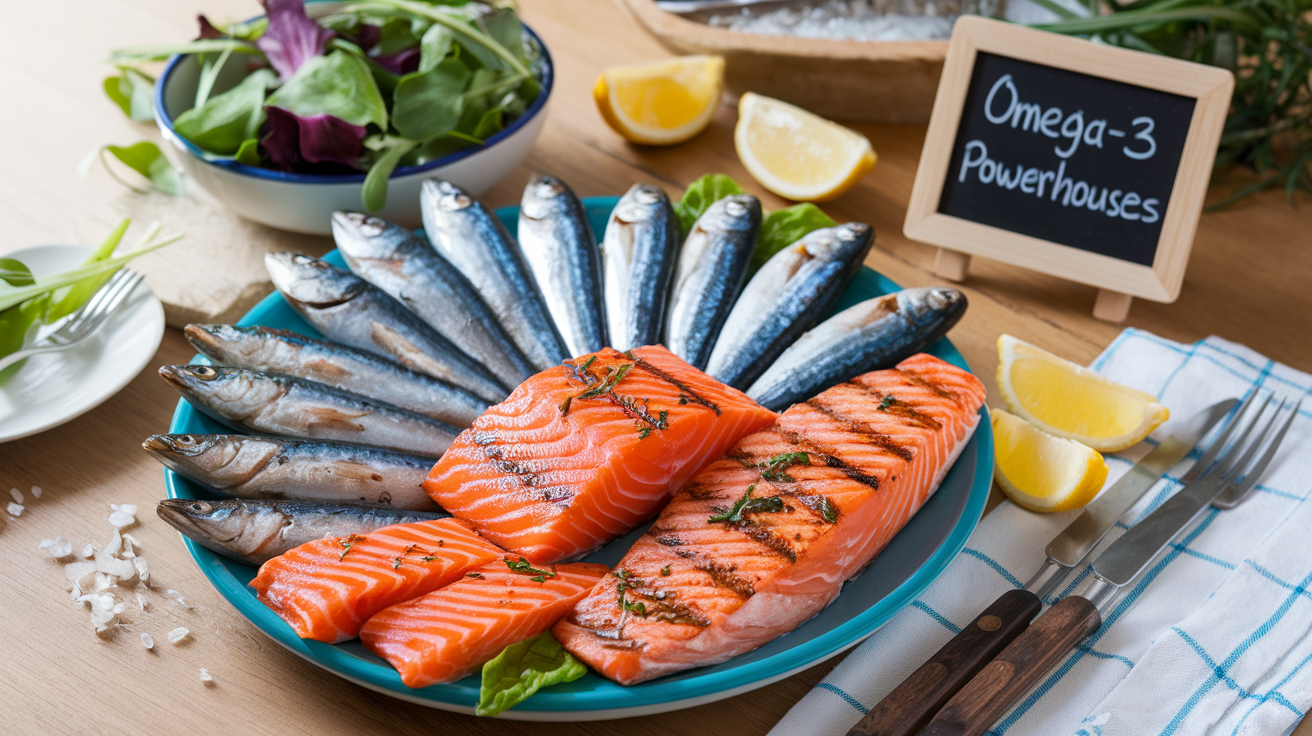
Now that we understand the basics of essential fatty acids, let’s dive into the most potent sources of these nutrients: fish. Fish are widely recognized as the ultimate powerhouses, providing substantial amounts of EPA and DHA, the most beneficial forms of these fats.
Salmon: King of essential fatty acids
Salmon reigns supreme in the world of essential fatty acid rich foods. This pink-fleshed fish is not only delicious but also packed with nutrients. A 3-ounce serving of salmon can provide up to 1,800 mg of essential fatty acids, making it one of the most efficient ways to meet your daily requirements.
- Wild-caught salmon typically contains more omega-3s than farm-raised
- Sockeye salmon is particularly rich in omega-3s and antioxidants
- Canned salmon is a convenient and affordable option
Mackerel: A nutrient-dense option
Mackerel is another excellent source of essential fatty acids, offering a robust flavor and numerous health benefits. This oily fish is not only rich in essential fatty acids but also provides vitamins D and B12, selenium, and protein.
| Mackerel Type | Omega-3 Content (per 3 oz) |
|---|---|
| Atlantic | 2,000 mg |
| King | 1,600 mg |
| Spanish | 1,400 mg |
Sardines: Small fish, big benefits
Don’t let their size fool you – sardines are nutritional powerhouses. These small, oily fish are not only rich in essential fatty acids but also provide calcium, vitamin D, and protein. Sardines are often consumed whole, which means you’re getting additional nutrients from their bones and organs.
Benefits of sardines:
- High omega-3 content (1,200 mg per 3 oz serving)
- Sustainable and low in mercury
- Versatile – can be eaten fresh, canned, or grilled
Tuna is a popular choice for many due to its mild flavor and wide availability. While not as high in omega-3s as salmon or mackerel, tuna still provides a significant amount, especially when consumed regularly.
Tuna is a popular choice for many due to its mild flavor and wide availability. While not as high in omega-3s as salmon or mackerel, tuna still provides a significant amount, especially when consumed regularly.
- Albacore (white) tuna contains more omega-3s than light tuna
- Fresh tuna steaks are an excellent source of omega-3s
- Canned tuna is a convenient option, but choose water-packed for higher omega-3 content
When incorporating these fish into your diet, it’s important to consider preparation methods. Baking, grilling, or steaming are healthier options compared to frying, which can reduce the essential fatty acid content and add unhealthy fats.
Remember, while these fish are excellent sources of omega-3s, it’s crucial to consume them as part of a balanced diet. The American Heart Association recommends eating fish at least twice a week to reap the full benefits of omega-3 fatty acids.
Plant-Based Sources
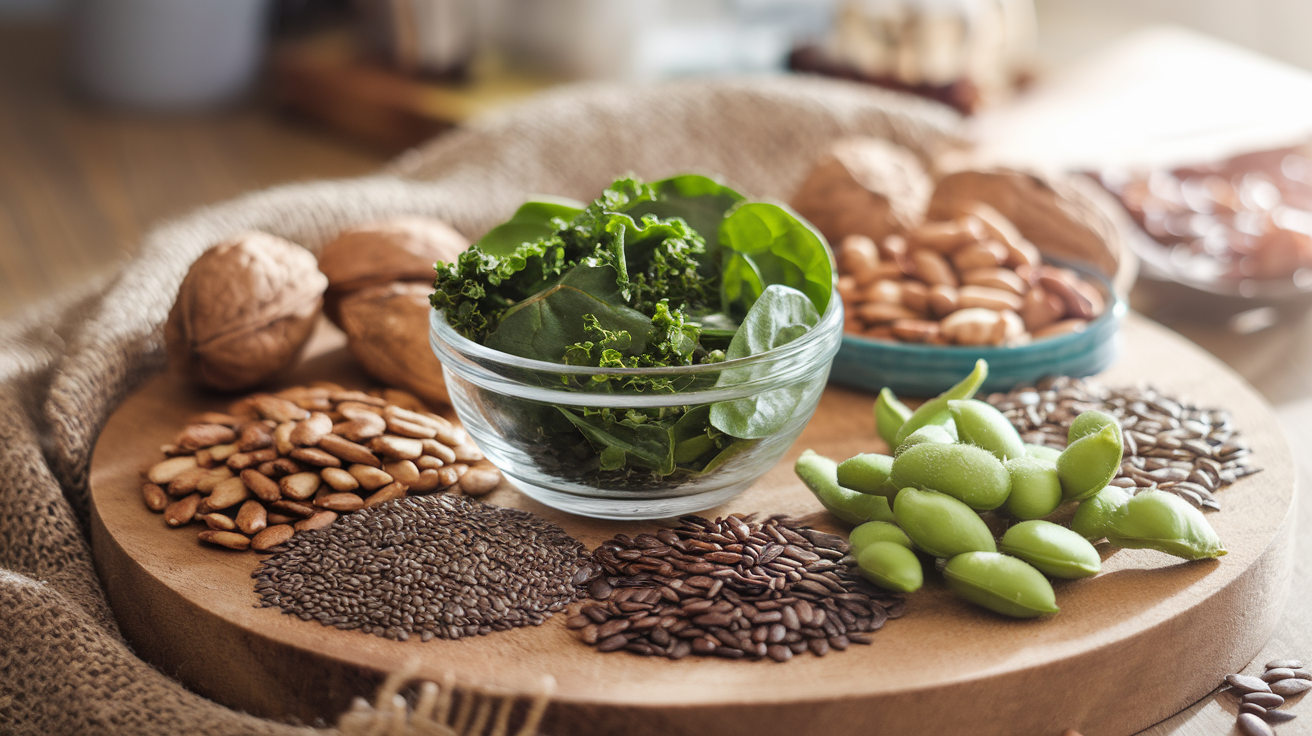
Flaxseeds: Tiny seeds, big impact
Flaxseeds are a powerhouse of plant-based omega-3 fatty acids, specifically alpha-linolenic acid (ALA). These tiny brown or golden seeds pack a significant nutritional punch, offering not only omega-3s but also fiber, protein, and lignans.
To maximize the absorption of omega-3s from flaxseeds:
- Grind them before consumption
- Store ground flaxseeds in an airtight container in the refrigerator
- Add to smoothies, yogurt, or baked goods
| Nutrient | Amount per 1 tbsp (10g) |
|---|---|
| Omega-3 (ALA) | 2.35g |
| Fiber | 2.8g |
| Protein | 1.9g |
| Lignans | 85.5mg |
Chia seeds: Ancient superfood
Chia seeds, once a staple in Aztec and Mayan diets, have regained popularity as a modern superfood. These tiny black or white seeds are rich in omega-3 fatty acids, fiber, and antioxidants.
Benefits of chia seeds:
- High in omega-3 ALA
- Excellent source of fiber
- Complete protein (containing all essential amino acids)
- Rich in minerals like calcium and phosphorus
Chia seeds can be easily incorporated into your diet by sprinkling them on salads, adding them to smoothies, or using them as an egg substitute in vegan baking.
Walnuts: Brain-boosting snack
Walnuts stand out among nuts for their high fatty acid content. Their unique shape, resembling a brain, is fitting given their potential cognitive benefits.
10 Ultimate fitness plans for staying healthy throughout lifefits of walnuts:
Key bene
- Heart health support
- Potential cognitive function improvement
- Anti-inflammatory properties
- Rich in polyphenols and vitamin E
Try incorporating walnuts into your diet as a snack, in salads, or as a topping for oatmeal and yogurt.
Hemp seeds: Complete protein and fatty acids
Hemp seeds, also known as hemp hearts, are a nutritional powerhouse offering a balance of omega-3 and omega-6 fatty acids, along with being a complete protein source. These small, nutty-flavored seeds are versatile and easy to incorporate into various dishes.
Nutritional profile of hemp seeds (per 3 tablespoons):
| Nutrient | Amount |
|---|---|
| Omega-3 (ALA) | 3g |
| Protein | 10g |
| Iron | 3mg |
| Magnesium | 210mg |
Hemp seeds can be sprinkled on salads, blended into smoothies, or used as a topping for yogurt and oatmeal. Their mild flavor makes them an excellent addition to many recipes without overpowering other ingredients.
While these plant-based sources offer significant amounts of essential fatty acids, it’s important to note that they primarily provide ALA, which the body must convert to EPA and DHA for optimal utilization. This conversion process is less efficient than directly consuming EPA and DHA from fish sources. However, for vegetarians, vegans, or those looking to diversify their intake, these plant-based options are excellent additions to a balanced diet.
Now that we’ve explored various fortified food options for boosting essential fatty acid intake, let’s consider how to incorporate these and other essential fat rich foods into your daily diet for maximum health benefits.
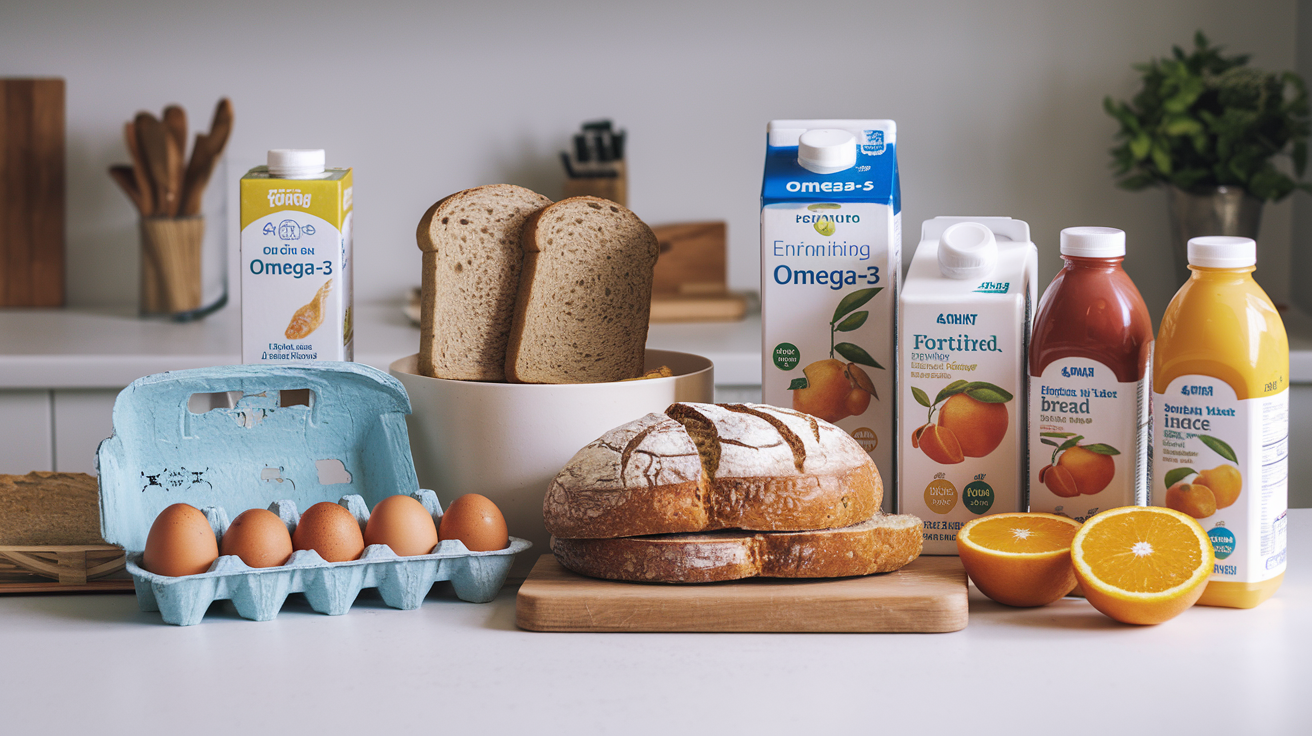
Omega-3 enriched eggs
For those who may not enjoy fish or plant-based sources, fortified foods offer an excellent alternative to boost your intake. Omega-3 enriched eggs are a prime example of how food technology has made it easier for consumers to access essential nutrients.
These eggs come from hens fed a diet rich in omega-3 fatty acids, typically through flaxseed or fish oil supplements. As a result, the eggs they produce contain significantly higher levels of omega-3s compared to conventional eggs. Here’s a comparison:
| Nutrient | Conventional Egg | Omega-3 Enriched Egg |
|---|---|---|
| Omega-3 (mg) | 30-50 | 100-500 |
| DHA (mg) | 20-30 | 50-150 |
| ALA (mg) | 10-20 | 50-350 |
Incorporating omega-3 enriched eggs into your diet is simple and versatile. Use them in:
- Breakfast dishes (omelets, scrambled eggs)
- Baked goods
- Salads
- Sandwiches
Fortified milk and yogurt
Dairy products are another category of foods commonly fortified with omega-3 fatty acids. Milk and yogurt producers have recognized the growing demand for healthier options and have responded by creating omega-3 enhanced versions of these popular items.
The fortification process typically involves adding fish oil or algal oil to the milk before processing. This results in a product that maintains its familiar taste and texture while offering the added benefits of omega-3s.
Key benefits of choosing fortified milk and yogurt:
- Increased omega-3 intake without changing dietary habits
- Improved calcium to omega-3 ratio for better nutrient absorption
- Suitable for individuals who don’t consume fish regularly
- Versatile use in cooking and baking
Omega-3 enhanced bread and pasta
For those who love their carbs, there’s good news: even bread and pasta can now be sources of omega-3 fatty acids. Manufacturers have developed methods to incorporate omega-3 rich ingredients into these staple foods without compromising taste or texture.
Omega-3 enhanced bread often contains ingredients like:
- Ground flaxseed
- Chia seeds
- Algal oil
Pasta fortified with omega-3s may use similar ingredients or be made with flour from omega-3 rich sources like flaxseed or chia.
When shopping for these products, look for labels that specify the omega-3 content. Keep in mind that while fortified foods can contribute to your overall omega-3 intake, they should not be relied upon as the sole source of these essential fatty acids.
Now that we’ve explored various fortified food options for boosting omega-3 intake, let’s consider how to incorporate these and other omega-3 rich foods into your daily diet for maximum health benefits.
Seafood Alternatives Rich in Fatty Acids
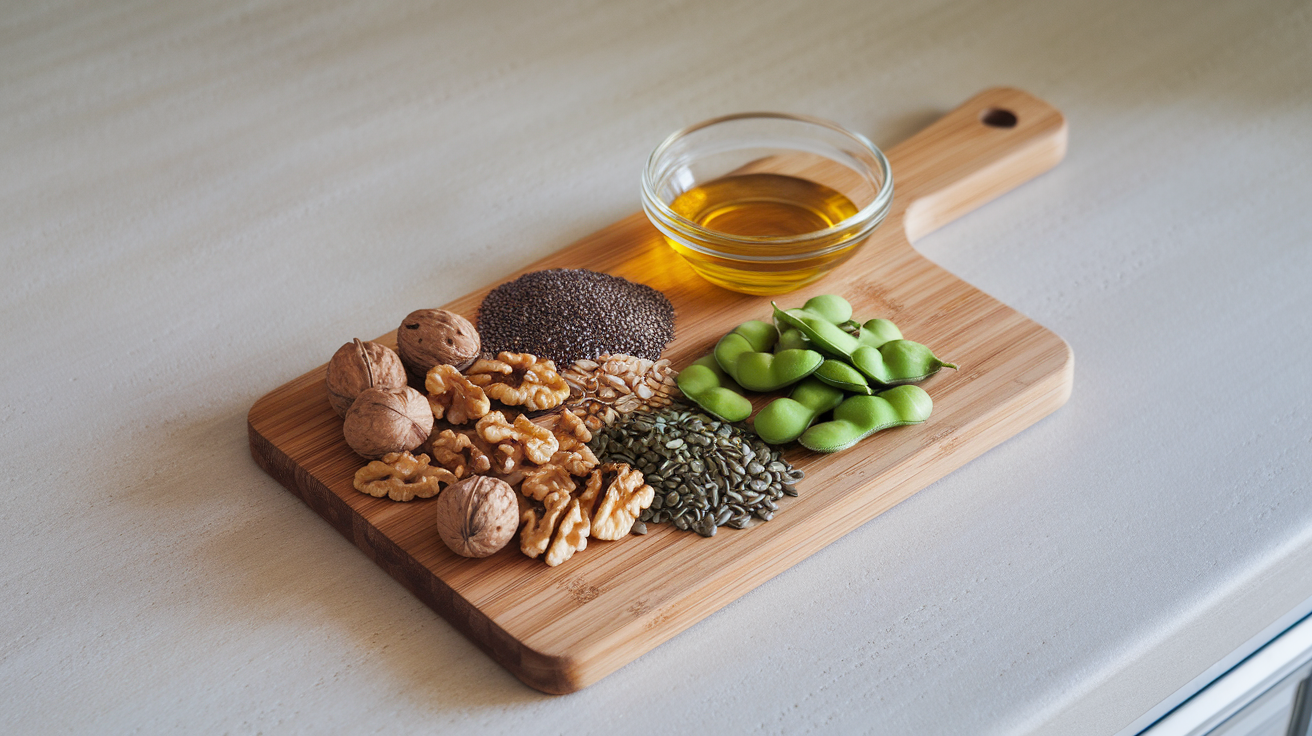
Now that we’ve explored various fish options for fatty acids, let’s dive into some delicious seafood alternatives that are equally rich in these nutrients.
Oysters: Zinc and Omega-3 combo
Oysters are not only a delicacy but also a nutritional powerhouse. These briny bivalves offer an impressive combination of omega-3 fatty acids and zinc, making them a top choice for health-conscious individuals.
- Omega-3 content: 100g of oysters contain approximately 435mg of omega-3 fatty acids
- Zinc content: Oysters are one of the best dietary sources of zinc, with 100g providing over 500% of the daily recommended intake
Oysters can be enjoyed raw, grilled, or baked, offering versatility in your omega-3 rich diet. Their unique flavor profile makes them a perfect addition to various dishes or as a standalone appetizer.
Mussels: Sustainable shellfish option
Mussels are an excellent sustainable seafood choice that packs a significant omega-3 punch. These shellfish are not only environmentally friendly but also offer numerous health benefits.
| Nutrient | Amount per 100g |
|---|---|
| Omega-3 fatty acids | 665mg |
| Protein | 24g |
| Vitamin B12 | 24µg (1000% DV) |
| Iron | 6.7mg (37% DV) |
Mussels are incredibly versatile in the kitchen. They can be steamed, baked, or added to pasta dishes, soups, and stews. Their mild, slightly sweet flavor makes them an excellent canvas for various seasonings and sauces.
Caviar: Luxurious Omega-3 indulgence
Caviar, often associated with luxury and fine dining, is also a concentrated source of omega-3 fatty acids. This delicacy comes from sturgeon fish eggs and offers a unique nutritional profile.
Key benefits of caviar:
- High omega-3 content: 100g of caviar contains approximately 6,000mg of omega-3 fatty acids
- Rich in vitamins: Particularly vitamin B12, D, and A
- Mineral-dense: Provides selenium, iron, and magnesium
While caviar is typically consumed in small quantities due to its intense flavor and high cost, even a small serving can contribute significantly to your omega-3 intake. It’s often served as a garnish or spread on blinis or crackers.
When incorporating these seafood alternatives into your diet, consider the following tips:
- Rotate between different options to ensure a varied nutrient intake
- Pay attention to sourcing and opt for sustainable, responsibly harvested seafood
- Experiment with different preparation methods to find your favorite ways to enjoy these omega-3 rich foods
By including these seafood alternatives in your diet, you’re not only boosting your omega-3 intake but also expanding your culinary horizons. Each option offers unique flavors and textures, making your journey to a healthier lifestyle more enjoyable and diverse. In the next section, we’ll explore practical ways to incorporate these and other omega-3 rich foods into your daily meals.
Incorporating Foods into Your Diet
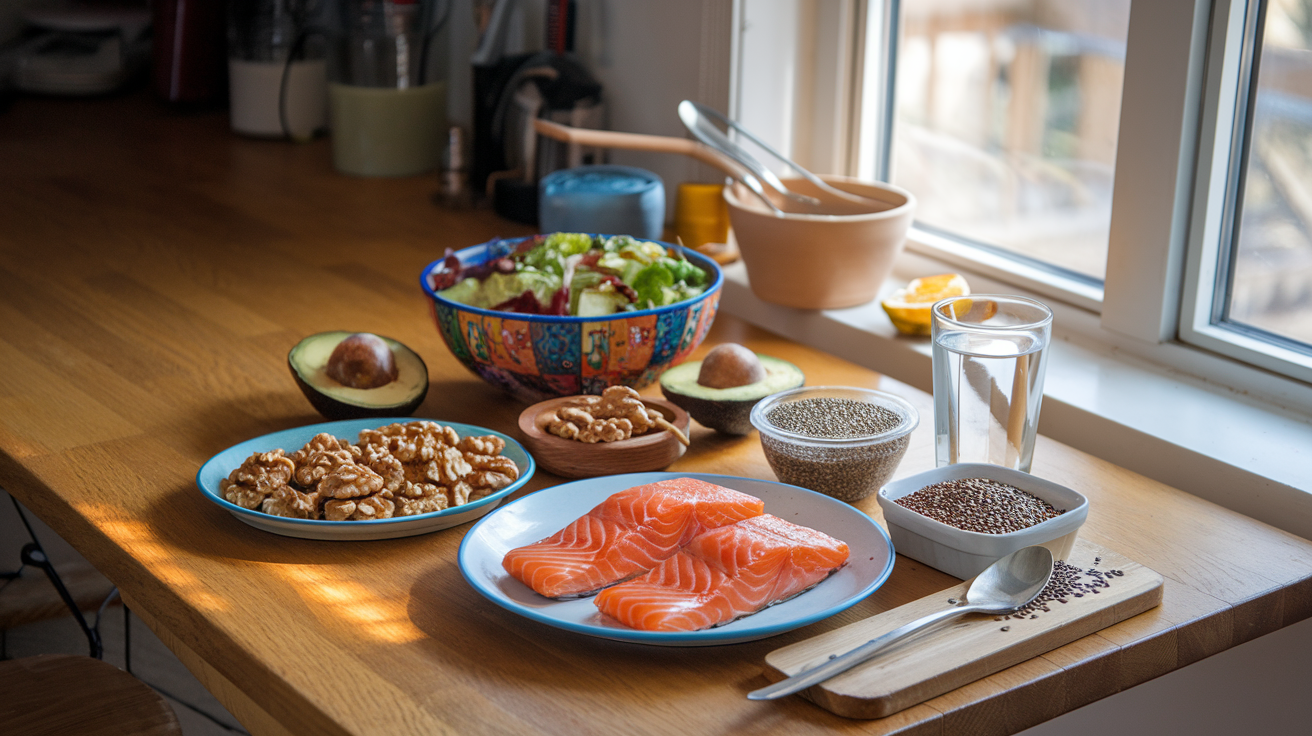
Simple meal ideas
Incorporating omega-3 foods into your diet doesn’t have to be complicated. Here are some simple meal ideas that can help you boost your omega-3 intake:
- Salmon salad bowl
- Chia seed pudding
- Tuna and avocado wrap
- Walnut and spinach smoothie
- Sardine toast
| Meal Idea | Omega-3 Sources | Additional Ingredients |
|---|---|---|
| Salmon salad bowl | Salmon | Mixed greens, cucumber, cherry tomatoes |
| Chia seed pudding | Chia seeds | Almond milk, berries, honey |
| Tuna and avocado wrap | Tuna, avocado | Whole wheat tortilla, lettuce, tomato |
| Walnut and spinach smoothie | Walnuts, flaxseed | Spinach, banana, almond milk |
| Sardine toast | Sardines | Whole grain bread, lemon juice, herbs |
These simple meal ideas combine omega-3-rich foods with other nutritious ingredients, making it easy to incorporate these essential fatty acids into your daily routine.
Omega-3 rich recipes
For those who enjoy cooking, try these omega-3 rich recipes to elevate your culinary experience:
- Grilled mackerel with lemon and herbs
- Flaxseed and blueberry pancakes
- Walnut-crusted baked cod
- Chia seed and kale salad
- Smoked salmon and avocado sushi rolls
These recipes not only provide a good dose of omega-3s but also offer a variety of flavors and textures to keep your meals interesting and enjoyable.
Balancing plant and animal sources
To ensure a well-rounded omega-3 intake, it’s important to balance plant and animal sources in your diet. Here’s how you can achieve this balance:
- Alternate fish and plant-based meals: Include fatty fish like salmon or mackerel in your diet 2-3 times a week, and on other days, focus on plant-based omega-3 sources like chia seeds, flaxseeds, or walnuts.
- Combine sources in single meals: Create dishes that incorporate both animal and plant omega-3s, such as a spinach salad with grilled sardines and a sprinkle of pumpkin seeds.
- Use plant-based omega-3s as toppings: Add ground flaxseeds or chia seeds to your yogurt, oatmeal, or smoothies for an easy omega-3 boost.
- Experiment with seaweed: Incorporate seaweed snacks or use nori sheets for sushi rolls to add variety to your plant-based omega-3 intake.
- Consider fortified foods: Use omega-3 fortified eggs or milk in your cooking to increase your intake from both animal and plant sources.
By implementing these strategies, you can ensure a diverse and balanced intake of omega-3 fatty acids from both plant and animal sources. This approach not only provides a wider range of nutrients but also caters to different dietary preferences and restrictions.
Incorporating essential fatty acids into your diet is a simple yet powerful way to enhance your overall health and well-being. From fatty fish like salmon and mackerel to plant-based sources such as chia seeds and walnuts, there are numerous delicious options to choose from. By consciously including these nutritious foods in your meals, you can reap the many benefits of essential fatty acids, including improved heart health, brain function, and reduced inflammation.
Health Benefits of a Rich Diet
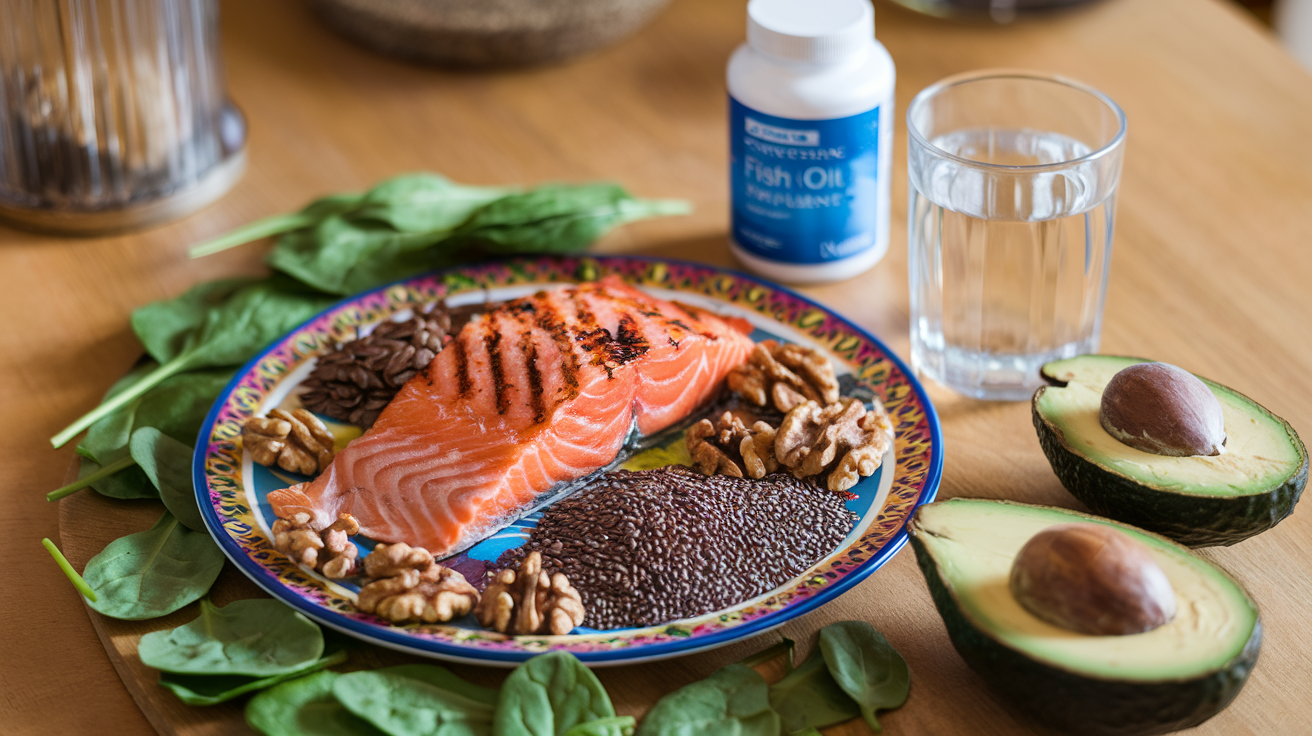
Heart health improvement
Incorporating these rich foods into your diet can significantly improve your heart health. These essential fatty acids have been shown to reduce the risk of cardiovascular diseases by lowering blood pressure, reducing triglycerides, increasing HDL (good) cholesterol, and decreasing the risk of arrhythmias.
- Lowering blood pressure
- Reducing triglycerides
- Increasing HDL (good) cholesterol
- Decreasing the risk of arrhythmias
| Omega-3 Source | Serving Size | Omega-3 Content (g) |
|---|---|---|
| Salmon | 3 oz | 1.5 |
| Mackerel | 3 oz | 1.0 |
| Sardines | 3 oz | 1.3 |
| Flaxseeds | 1 tbsp | 2.3 |
| Chia seeds | 1 oz | 5.0 |
Brain function enhancement
Omega-3 fatty acids play a crucial role in brain health and cognitive function. DHA, a type of omega-3, is a major structural component of brain cells. Regular consumption of omega-3 rich foods can:
- Improve memory and cognitive performance
- Reduce the risk of age-related cognitive decline
- Support better mental health and mood regulation
- Potentially lower the risk of neurodegenerative diseases like Alzheimer’s
Studies have shown that individuals with higher levels of omega-3s in their blood tend to have larger brain volumes in old age, suggesting a protective effect against brain shrinkage associated with aging.
Inflammation reduction
One of the most significant benefits of an omega-3 rich diet is its powerful anti-inflammatory properties. Chronic inflammation is linked to various health issues, including heart disease, cancer, and autoimmune disorders. Omega-3s can help:
- Reduce the production of inflammatory molecules
- Balance the body’s inflammatory response
- Support overall immune function
Regular consumption of omega-3 rich foods like walnuts, flaxseeds, and fatty fish can help manage chronic inflammation and potentially reduce the risk of inflammation-related diseases.
Joint pain relief
For those suffering from joint pain or arthritis, incorporating omega-3 rich foods into the diet can provide significant relief. The anti-inflammatory properties of omega-3s can:
- Reduce joint stiffness and tenderness
- Improve mobility and flexibility
- Decrease the need for anti-inflammatory medications
While omega-3s are not a cure for arthritis, they can be an effective complementary approach to managing symptoms and improving quality of life for those with joint issues.
Skin health promotion
Omega-3 fatty acids are essential for maintaining healthy, radiant skin. These nutrients contribute to skin health by:
- Supporting the skin’s lipid barrier, which helps retain moisture
- Reducing inflammation that can lead to acne and other skin conditions
- Protecting against sun damage and premature aging
- Promoting the production of collagen and elastin for skin elasticity
These nutrients contribute to skin health by supporting the skin’s lipid barrier, which helps retain moisture, reducing inflammation that can lead to acne and other skin conditions, protecting against sun damage and premature aging, and promoting the production of collagen and elastin for skin elasticity.
Now that we’ve explored the numerous health benefits of an omega-3 rich diet, it’s important to consider potential risks and considerations when incorporating these foods into your daily meals.
Potential Risks and Considerations

Mercury content in fish
While fish is an excellent source of omega-3 fatty acids, it’s important to be aware of potential mercury contamination. Some fish species, particularly large predatory fish, tend to accumulate higher levels of mercury in their tissues. This can pose health risks, especially for pregnant women, nursing mothers, and young children.
Here’s a table comparing mercury levels in common fish species:
| Low Mercury | Moderate Mercury | High Mercury |
|---|---|---|
| Salmon | Halibut | Shark |
| Sardines | Snapper | Swordfish |
| Trout | Tuna (canned) | King Mackerel |
| Anchovies | Mahi-mahi | Tilefish |
To minimize mercury exposure while still benefiting from omega-3s, aim to consume a variety of fish and focus on those lower in mercury.
Allergies and sensitivities
Some individuals may have allergies or sensitivities to certain omega-3 rich foods, particularly fish and seafood. Common symptoms of fish allergies include:
- Hives or skin rash
- Nausea and vomiting
- Stomach cramps
- Headaches
- Difficulty breathing
For those with fish allergies, plant-based sources of omega-3s like flaxseeds, chia seeds, and walnuts can be excellent alternatives.
Interaction with medications
Omega-3 fatty acids, especially when consumed in high amounts or through supplements, may interact with certain medications. Some key interactions to be aware of include:
- Blood thinners (e.g., warfarin)
- Blood pressure medications
- Diabetes medications
It’s crucial to consult with a healthcare provider before significantly increasing omega-3 intake, particularly if you’re on any medications.
Proper storage of Omega-3 rich foods
To maintain the quality and nutritional value of omega-3 rich foods, proper storage is essential. Omega-3 fatty acids are prone to oxidation, which can lead to rancidity and loss of nutritional benefits.
Here are some storage tips for common omega-3 rich foods:
- Fish: Store fresh fish in the coldest part of the refrigerator and consume within 1-2 days. For longer storage, freeze immediately.
- Nuts and seeds: Keep in airtight containers in a cool, dry place. For extended shelf life, store in the refrigerator or freezer.
- Flaxseed oil: Refrigerate and use within a few weeks of opening.
- Fish oil supplements: Store in a cool, dark place away from direct sunlight.
By being aware of these potential risks and considerations, you can safely incorporate omega-3 rich foods into your diet and maximize their health benefits. Remember to consult with a healthcare professional for personalized advice, especially if you have any pre-existing health conditions or concerns.

Incorporating essential fatty acids into your diet is a simple yet powerful way to enhance your overall health and well-being. From fatty fish like salmon and mackerel to plant-based sources such as chia seeds and walnuts, there are numerous delicious options to choose from. By consciously including these nutritious foods in your meals, you can reap the many benefits of essential fatty acids, including improved heart health, brain function, and reduced inflammation.
Remember, while these foods offer significant health advantages, it’s essential to maintain a balanced diet and consult with a healthcare professional before making major dietary changes. Start small by incorporating a few of these powerhouses into your weekly meal plan and gradually increase your intake. Your body will thank you for nourishing it with these essential nutrients, paving the way for a healthier, more vibrant lifestyle.
Incorporating essential fatty acids into your diet is a simple yet powerful way to enhance your overall health and well-being. From fatty fish like salmon and mackerel to plant-based sources such as chia seeds and walnuts, there are numerous delicious options to choose from. By consciously including these nutritious foods in your meals, you can reap the many benefits of essential fatty acids, including improved heart health, brain function, and reduced inflammation.
It’s important to consume a variety of nutrient sources to maintain a balanced diet.
Share this content:
